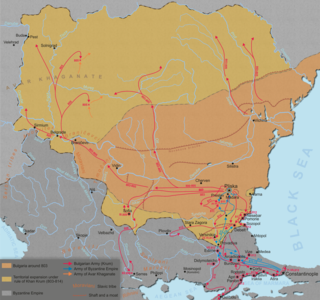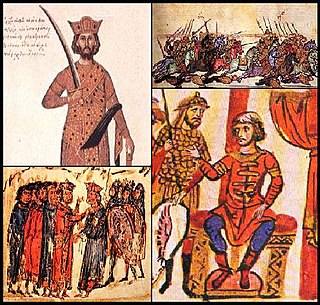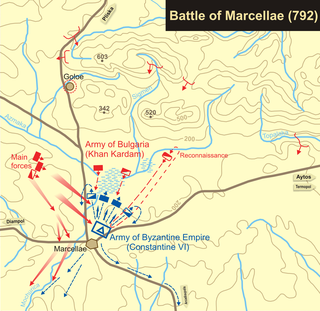
Krum, often referred to as Krum the Fearsome was the Khan of Bulgaria from sometime between 796 and 803 until his death in 814. During his reign the Bulgarian territory doubled in size, spreading from the middle Danube to the Dnieper and from Odrin to the Tatra Mountains. His able and energetic rule brought law and order to Bulgaria and developed the rudiments of state organization.

Pliska was the first capital of the First Bulgarian Empire during the Middle Ages and is now a small town in Shumen Province, on the Ludogorie plateau of the Danubian Plain, 20 km northeast of the provincial capital, Shumen.

Ivan Asen I, also known as Asen I or John Asen I, was emperor or tsar of Bulgaria from 1187/1188 to 1196 as co-ruler with his elder brother, Peter II. Hailing from the Byzantine theme of Paristrion, his exact place and date of birth are unknown. Most contemporaneous chronicles describe Asen and his brothers, Theodor (Peter) and Kaloyan, as Vlachs but they were probably of mixed Bulgarian, Cuman and Vlach ancestry.
Kormisosh, also known as Kormesiy, Kormesios, Krumesis, Kormisoš, or Cormesius, was a ruler of Bulgaria during the 8th century, recorded in a handful of documents. Modern chronologies of Bulgarian rulers place him either as the successor of Tervel and predecessor of Sevar, or the successor of Sevar and predecessor of Vineh.

The First Bulgarian Empire was a medieval state that existed in Southeastern Europe between the 7th and 11th centuries AD. It was founded in 680–681 after part of the Bulgars, led by Asparuh, moved south to the northeastern Balkans. There they secured Byzantine recognition of their right to settle south of the Danube by defeating – possibly with the help of local South Slavic tribes – the Byzantine army led by Constantine IV. During the 9th and 10th century, Bulgaria at the height of its power spread from the Danube Bend to the Black Sea and from the Dnieper River to the Adriatic Sea and became an important power in the region competing with the Byzantine Empire.

The Battle of Versinikia was fought in 813 between the Byzantine Empire and the Bulgarian Empire, near the city of Adrianople (Edirne) in modern-day Turkey.
Ivanko, also referred to by some scholars as Ivanko-Alexius, was a Vlach boyar who killed his cousin Ivan Asen I, the ruler of the renascent Second Bulgarian Empire, in 1196. He was a leader of local Vlachs and Bulgarian Slavs.

Peter II, born Theodor, also known as Theodor-Peter, was the first emperor or tsar of the restored Bulgarian Empire from 1185 to 1197. He hails from the Byzantine theme of Paristrion, although his exact place and date of birth are unknown.

The Byzantine–Bulgarian wars were a series of conflicts fought between the Byzantine Empire and Bulgaria which began after the Bulgars conquered parts of the Balkan peninsula after 680 AD. The Byzantine and First Bulgarian Empire continued to clash over the next century with variable success, until the Bulgarians, led by Krum, inflicted a series of crushing defeats on the Byzantines. After Krum died in 814, his son Omurtag negotiated a thirty-year peace treaty. Simeon I had multiple successful campaigns against the Byzantines during his rule from 893 to 927. His son Peter I negotiated another long-lasting peace treaty. His rule was followed by a period of decline of the Bulgarian state.

The Battle of Marcellae was fought in 792 between the forces of the Byzantine Empire, led by Constantine VI, and those of the First Bulgarian Empire under Kardam. The Byzantines were routed and forced to retreat to Constantinople. Fighting took place at Marcellae (Markeli), near the modern town of Karnobat in southeastern Bulgaria, the same site as an earlier battle in 756.

The Battle of Litosoria or Lithosoria occurred between the Byzantines and Bulgars in the fall of 774 at an unknown place named Litosoria. It was located in the border area between both states, in the region of Zagore, probably north of the line Kirklareli - Vize in modern Turkey. The result was a Byzantine victory.

The Uprising of Georgi Voyteh was a Bulgarian uprising in the Byzantine theme of Bulgaria in 1072. It was the second major attempt to restore the Bulgarian Empire after the Uprising of Peter Delyan in 1040-1041.

The battle of Marcellae took place in 756 between the armies of the First Bulgarian Empire and the Byzantine Empire at Markeli, near the town of Karnobat in south eastern Bulgaria. The result was a Byzantine victory.

From c. 970 until 1018, a series of conflicts between the Bulgarian Empire and the Byzantine Empire led to the gradual reconquest of Bulgaria by the Byzantines, who thus re-established their control over the entire Balkan peninsula for the first time since the 7th-century Slavic invasions. The struggle began with the incorporation of eastern Bulgaria after the Russo-Byzantine War (970–971). Bulgarian resistance was led by the Cometopuli brothers, who – based in the unconquered western regions of the Bulgarian Empire – led it until its fall under Byzantine rule in 1018.

The Palace of Omurtag or Aul (Aulē) of Omurtag is an archaeological site in northeastern Bulgaria dating to Late Antiquity and the Early Middle Ages located near the village of Han Krum in Shumen Province. The site has been pinpointed as the location of a fort and palace of Omurtag, ruler (kanasybigi) of the First Bulgarian Empire in 815–831, as mentioned in the Chatalar Inscription of 822. Earlier structures in the vicinity of the fortress have been identified as the Arian episcopal see of a Gothic bishop.
Kardam was the ruler of the First Bulgarian Empire.
Ktenia is a ruined Roman and medieval fortress, 2.1 kilometres (1.3 mi) north of the village of Lozarevo in Sungurlare Municipality, Burgas Province, south-eastern Bulgaria. In the Middle Ages, Ktenia often changed hands between Bulgaria and Byzantium.
Lardea or Lardeya is a ruined late Roman and medieval fortress, situated near the village of Lozenets in Straldzha Municipality, Yambol Province, south-eastern Bulgaria. In the Middle Ages, Lardea often changed hands between Bulgaria and Byzantium.
This is a list of people, places, and events related to the medieval Bulgarian Empires — the First Bulgarian Empire (681–1018), and the Second Bulgarian Empire (1185–1396).



















